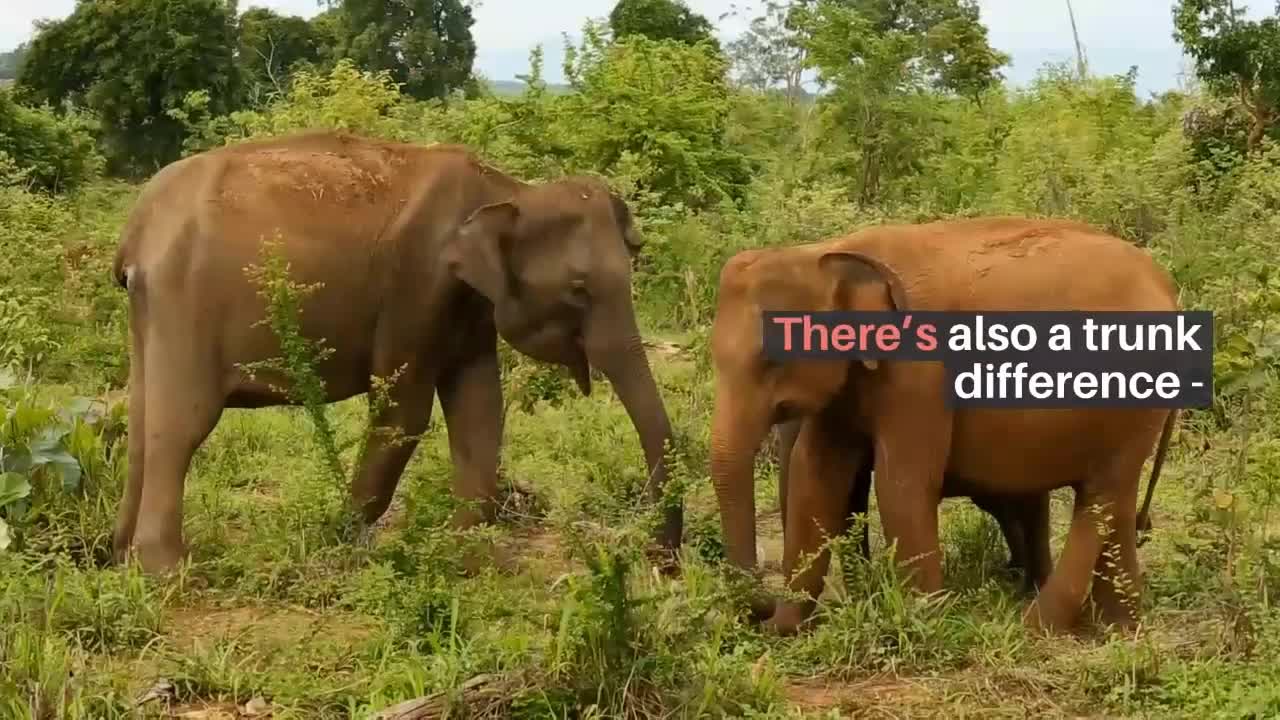Premium Only Content

Top 10 facts about elephants Herd of African bush elephants
TOP 10 FACTS ABOUT ELEPHANTS
ADOPT AN ELEPHANT
MORE ANIMAL FACTS
PLAY
African elephant, South Africa © WWF-US / Colby Locks
1. THEY’RE THE WORLD’S LARGEST LAND ANIMAL
The African elephant is the world's largest land mammal – with males on average measuring up to 3 m high and weighing up to 6 tonnes. Males only reach their full size at 35-40 years - that’s well over half their lifespan, as wild elephants can live for up to 60-70 years. And it’s not just the adults – even calves are huge! At birth, elephants can weigh 120 kg - that’s almost 19 stone.
Asian elephants © David Lawson / WWF-UK
2. YOU CAN TELL THE TWO SPECIES APART BY THEIR EARS
There are two species of elephant: African and Asian. The ears of African elephants are much larger than their cousins and are described as being shaped like the African continent, whereas the ears of Asian elephants are shaped like the Indian subcontinent. There’s also a trunk difference - African elephants have two ‘fingers’ at the tip of their trunks, whereas Asian elephants have one.
Asian elephants bathing, Sumatra, Indonesia © naturepl.com / Nick Gar butt / WWF
3. THEIR TRUNKS HAVE MAD SKILLS
Elephants have around 150,000 muscle units in their trunk. Their trunks are perhaps the most sensitive organ found in any mammal - Asian elephants have been seen to pick up a peanut, shell it, blow the shell out and eat the nut. Elephants use their trunks to suck up water to drink – it can contain up to 8 liters of water. They also use their trunks as a snorkel when swimming.
African elephant herd, Masai Mara, Kenya naturepl.com / Dnis-Huot / WWF
4. THEIR TUSKS ARE ACTUALLY TEETH
Elephant tusks are actually enlarged incisor teeth which first appear when elephants are around 2 years old. Tusks continue growing throughout their lives. Tusks are used to help with feeding - prising bark off trees or digging up roots - or as a defense when fighting. But these beautiful tusks often cause elephants danger. They're made from ivory; a much desired object. Read on to find out why elephants are under threat.
An elephant covers itself in dust and dirt in the Masai Mara, Kenya Jennifer Hunt / WWF-UK
5. THEY’VE GOT THICK SKIN
An elephant’s skin is 2.5 cm thick in most places. The folds and wrinkles in their skin can retain up to 10 times more water than flat skin does, which helps to cool them down. They keep their skin clean and protect themselves from sunburn by taking regular dust and mud baths.
African elephant eating, Zimbabwe © Paul Sky
6. ELEPHANTS ARE CONSTANTLY EATING
Elephants need up to 150 kg of food per day – that's around 375 tins of baked beans, although half of this may leave the body undigested. They eat so much that they can spend up to three-quarters of their day eating.
African elephants caught on camera trap, Namibia © Will Burrrd-Lucas / WWF-US
7. THEY COMMUNICATE THROUGH VIBRATIONS
Elephants communicate in a variety of ways - including sounds like trumpet calls (some sounds are too low for people to hear), body language, touch and scent. They can also communicate through seismic signals - sounds that create vibrations in the ground - which they may detect through their bones.
African elephant calf and its mother, Ambrose National Park, Kenya © Martin Harvey / WWF
8. CALVES CAN STAND WITHIN 20 MINUTES OF BIRTH
Amazingly, elephant calves are able to stand within 20 minutes of being born and can walk within 1 hour. After two days, they can keep up with the herd. This incredible survival technique means that herds of elephants can keep migrating to find food and water to thrive.
© Julia, Thailand / WWF-Germany
9. AN ELEPHANT NEVER FORGETS
The elephant's temporal lobe (the area of the brain associated with memory) is larger and denser than that of people - hence the saying 'elephants never forget'.
© WWF / James Morgan
10. AROUND 90% OF AFRICAN ELEPHANTS HAVE BEEN WIPED OUT IN THE PAST CENTURY
Around 90% of African elephants have been wiped out in the past century - largely due to the ivory trade - leaving an estimated 415,000 wild elephants alive today. Asian elephants are also under threat, having declined by at least 50% in the last three generations. There are only around 45,000 left in the wild. As their habitat changes, fragments and is lost to human settlements and agriculture, populations of Asian elephants are finding it harder to follow their traditional migration routes to reach water, feeding and breeding grounds, and they’re coming into often dangerous contact with people.
© Austin Kane / WWF-Kenya
WWF'S WORK
We work in East Africa and across Asia to protect and manage elephant habitat and create safe ‘wildlife corridors’ so elephants can migrate safely.
We also support local people to live alongside elephants by protecting their fields from crop-raiding animals using solar-powered electric fences and by installing beehives (elephants hate bees).
© Thomas Cristofoletti / WWF-US
AND WE’RE MONITORING ELEPHANTS...
...by regularly surveying them and fitting GPS collars to track their movements, to keep both elephants and people safe.
We’re determined to stop the illegal wildlife trade by supporting community scouts, rangers, sniffer dogs and wildlife trade monitoring networks, to deter poachers and stamp out demand from would-be buyers.
But we couldn’t do all this without your support.
-
 LIVE
LIVE
Steven Crowder
1 hour agoI'm A Democrat Icon!
11,849 watching -
 LIVE
LIVE
Tim Pool
15 hours agoIs Trump Still Winning? | The Culture War LIVE Debate
1,288 watching -
 DVR
DVR
VINCE
2 hours agoThe Kamala Comeback Is Here | Episode 94 - 08/01/25
57.5K41 -
 LIVE
LIVE
LFA TV
14 hours agoLFA TV ALL DAY STREAM - FRIDAY 8/1/25
4,461 watching -
 1:47:49
1:47:49
Dear America
2 hours agoHILLARY EXPOSED!! New Files Reveal She Was Behind It ALL!!! + Kamala Breaks Silence!!
84.5K68 -
 LIVE
LIVE
The Big Mig™
3 hours agoHillary Clinton & George Soros To GITMO NOW!!!
5,078 watching -
 LIVE
LIVE
Badlands Media
7 hours agoBadlands Daily: Aug 1, 2025
4,258 watching -
 LIVE
LIVE
Matt Kohrs
10 hours agoTrump Tanks Stocks, Breaking Market News & Payday Friday || Live Trading
606 watching -
 13:42
13:42
China Uncensored
13 hours agoChina's Invasion Has Begun
7.22K18 -
 LIVE
LIVE
Wendy Bell Radio
6 hours agoBUSTED
8,431 watching